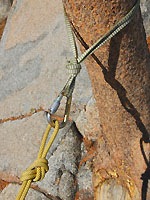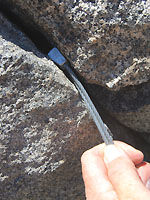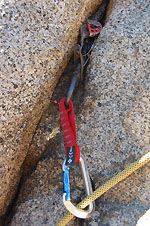By Bela G. Vadasz, ASI
Good Pro
 Natural anchors are features of rock or trees that can usually be slung with nylon webbing or cord. The climbing rope can then be attached to the sling with a carabiner.
Natural anchors are features of rock or trees that can usually be slung with nylon webbing or cord. The climbing rope can then be attached to the sling with a carabiner. Artificial anchors are usually wedge-shaped "nuts" with a swaged cable or spring-loaded mechanical camming devices that can be inserted into cracks in the rock. These can be easily placed and removed to create solid, strong anchors with very little to no damage to the rock, a.k.a. "clean climbing." Some routes may have permanently placed pitons driven into a crack with a hammer or blank areas with no cracks may have expansion bolts that have been placed into holes drilled in the rock. Many "sport routes" rely predominantly on expansion bolts and placement of additional pro is unnecessary.
Placing Good Stoppers
 Look around for the best placement. Check and test the rock to make sure it's solid. Anticipate the potential direction of pull, hopefully downward not outward. Look for the wider portion of the crack and find the ideal spot where it tapers narrower. Inspect to make sure it doesn't flare out. Anticipate the size of the ideal spot of the taper. Reach for the carabiner off your rack with the three stoppers closest to the estimated size. Try placing one while still on the carabiner with the other two. If it's not the right size try the next one smaller or larger. Look to see that there is good surface contact on both sides of the nut. Place the stopperŪ with the greatest surface area in contact with the maximum amount of contact with the rock as possible.
Look around for the best placement. Check and test the rock to make sure it's solid. Anticipate the potential direction of pull, hopefully downward not outward. Look for the wider portion of the crack and find the ideal spot where it tapers narrower. Inspect to make sure it doesn't flare out. Anticipate the size of the ideal spot of the taper. Reach for the carabiner off your rack with the three stoppers closest to the estimated size. Try placing one while still on the carabiner with the other two. If it's not the right size try the next one smaller or larger. Look to see that there is good surface contact on both sides of the nut. Place the stopperŪ with the greatest surface area in contact with the maximum amount of contact with the rock as possible. Ideally the nut is placed such that the greater the pull in the anticipated direction, the stronger the nut holds. If it's a wired stopperŪ placed to protect a lead, use two carabiners with a sling in between or a quick draw to reduce the chance of the rope traveling through the carabiners and creating an upward pull and dislodging the nut. Avoid using two carabiners on each other. That's a No-No because, with a twist, one could dislodge from pressure on the other.
Solid Camming Devices
 Camming units (aka CamalotsŪ, FriendsŪ, etc) are spring loaded "active protection". They usually have 3 or 4 lobes. By retracting the lever, the width of the lobes on the unit become smaller. It can be inserted into a good crack and when you let go of the trigger, the unit expands to match the width of the crack. Check all the lobes. Ideally, contact should be in the center third of each and every lobe. They're designed such that if placed correctly, in a good crack in solid rock, the harder you pull, the better they hold (up to their limit, which is very high).
Camming units (aka CamalotsŪ, FriendsŪ, etc) are spring loaded "active protection". They usually have 3 or 4 lobes. By retracting the lever, the width of the lobes on the unit become smaller. It can be inserted into a good crack and when you let go of the trigger, the unit expands to match the width of the crack. Check all the lobes. Ideally, contact should be in the center third of each and every lobe. They're designed such that if placed correctly, in a good crack in solid rock, the harder you pull, the better they hold (up to their limit, which is very high).Practice in a controlled, safe environment. Build your skills and confidence, then enjoy the rewards of traditional adventure, all as part of being a well rounded rock climber.
Bela G. Vadasz started rock climbing in the late 60's when driving pitons and tiny bolts were the only form of artificial anchors. Since then, he has taught hundreds of students "state-of-the-art" techniques that follow the evolution of climbing gear.